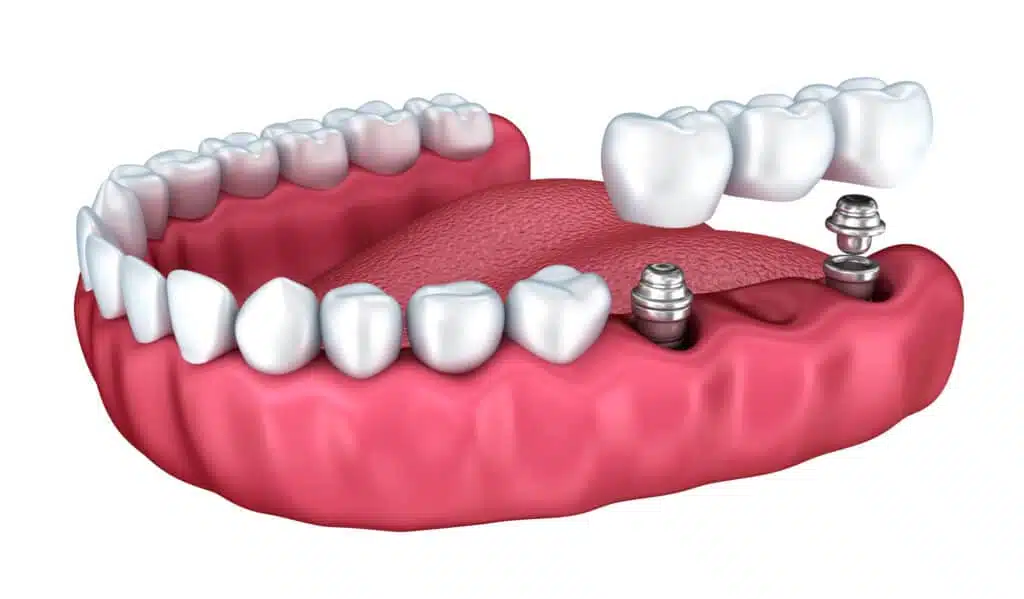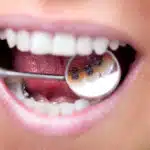Dental bridges are a good solution for closing gaps between teeth. Here you can find out everything about the types, procedure, costs, advantages and disadvantages.
Dental bridges are a popular solution for closing gaps between teeth caused by the loss of one or more teeth.
They not only offer aesthetic benefits, but also support the function of your teeth by improving chewing function and speech.
In this article, you will learn everything you need to know about dental bridges – from the different types and the treatment procedure to the advantages, disadvantages and costs involved.
| Get 150 € discount on your dental correction! |

Book a consultation appointment now at a nearby DrSmile partner practice and find out if teeth straightening with aligners is right for you.
The appointment is completely non-binding and does not involve any costs.
With the code “THATSMILE150” you will receive 150 € discount on the treatment.
What is a dental bridge?
A dental bridge is a fixed prosthesis that closes a gap between teeth by attaching it to the adjacent teeth (the so-called abutment teeth).
The missing tooth is replaced by a pontic, which can be made of different materials.
Dental bridges can be used when one or more teeth are missing and the neighboring teeth are strong enough to serve as abutments.

Types of dental bridges
There are different types of dental bridges that are used depending on the situation and condition of your teeth. The most common types are:
1. conventional dental bridge
The conventional dental bridge is the most common form. It consists of one or more pontics that are attached to crowns. The crowns are anchored to the adjacent teeth, which must first be prepared. This type of bridge is suitable if the adjacent teeth are healthy and stable enough to serve as support.
2. adhesive bridge (Maryland bridge)
With the adhesive bridge, also known as the Maryland bridge, the pontic is held in place by wings that are attached to the adjacent teeth. This variant is minimally invasive, as the adjacent teeth do not have to be ground down. It is particularly suitable for small gaps between teeth and is an aesthetic solution, especially in the anterior region.
3. free-end bridge
A free-end bridge is used when the last molar tooth is missing and therefore only one abutment tooth is present. This type of bridge is attached to only one abutment on one side, which means a higher load on this tooth. Free-end bridges are often used when an implant solution is not possible or desired.
4. implant-supported bridge
In an implant-supported bridge, implants are used as abutments instead of natural teeth. This option can be considered if several adjacent teeth are missing or the neighboring teeth are not stable enough to serve as supports. Implant-supported bridges are a durable and stable solution, but require a surgical procedure to place the implants.

Treatment procedure
The procedure for making and fitting a dental bridge is carried out in several stages and usually requires several appointments with the dentist:
1. initial examination and planning
First, a thorough examination is carried out to assess the health of the teeth. The dentist will check whether the neighboring teeth are strong enough to serve as abutments. They will also check which type of bridge is best suited to your situation. X-rays or impressions may be necessary to assess the exact condition of your teeth.
2. preparation of the abutment teeth
For a conventional bridge, the adjacent teeth must be prepared by grinding them down and preparing them to receive the crowns. This is done under local anesthesia so that you do not feel any pain. With an adhesive bridge, this step is less invasive as the teeth do not have to be ground down.
3. impression taking and temporary dentures
After the teeth have been prepared, an impression of the dentition is taken. This impression serves as the basis for making the bridge in the dental laboratory. While the final bridge is being made, you will usually receive a temporary denture to temporarily close the gap and protect the teeth.
4. fitting and adjustment
As soon as the dental bridge is finished, it is inserted in an initial fitting to check the fit, esthetics and bite. If necessary, the dentist will make adjustments to ensure that the bridge fits perfectly.
5. inserting the dental bridge
Once everything has been optimally adjusted, the bridge is firmly cemented to the abutment teeth or implants. The dentist then checks the bite and function of the bridge once again to ensure that everything fits perfectly.
| Get 150 € discount on your dental correction! |

Book a consultation appointment now at a nearby DrSmile partner practice and find out if teeth straightening with aligners is right for you.
The appointment is completely non-binding and does not involve any costs.
With the code “THATSMILE150” you will receive 150 € discount on the treatment.
Advantages of dental bridges
Dental bridges offer numerous advantages, both functional and esthetic:
- Closing the gap between teeth: A dental bridge closes gaps and thus restores the chewing function and aesthetics of the dentition.
- Improved pronunciation: Missing teeth can impair the ability to speak. A bridge helps to correct these problems.
- Prevent teeth from shifting: If a gap between teeth is not filled, the neighboring teeth tend to shift into the gap. This can impair the bite and jaw function. A bridge holds the neighboring teeth in position.
- Stable solution: Dental bridges are firmly anchored in the mouth and offer a stable solution that feels natural when speaking and chewing.
Disadvantages of dental bridges
Despite the numerous advantages, there are also some disadvantages that you should bear in mind:
- Grinding down the abutment teeth: With conventional bridges, the neighboring teeth have to be ground down, which leads to a loss of healthy tooth substance.
- Higher load on the abutment teeth: The abutment teeth carry the entire load of the bridge, which can make them more susceptible to decay or tooth damage if oral hygiene is not optimal.
- Cost: Dental bridges are often more expensive than removable dentures, especially implant-supported bridges. This can be an important factor in the choice of treatment.
- Lifespan: Although dental bridges are durable, they do not usually last a lifetime. They may need to be replaced or repaired after a few years.

Costs of a dental bridge
The cost of a dental bridge can vary greatly depending on the type of bridge, the materials used and the individual treatment required.
A simple conventional bridge can cost between 500 and 1,500 euros per tooth, while implant-supported bridges can be significantly more expensive – up to 3,000 euros or more per tooth.
Health insurance companies generally pay a fixed allowance for dental bridges, which is based on the cost of a simple restoration.
The co-payment depends on the type of bridge chosen and the materials used. It is important to find out in advance from your health insurance provider which costs will be covered.
Conclusion: Dental bridges as dentures
Dental bridges are an effective and aesthetically pleasing solution for closing gaps between teeth and restoring the function of the dentition.
They offer numerous advantages, such as stabilizing the adjacent teeth and improving chewing function and pronunciation.
There are different types of dental bridges that can be selected depending on the individual dental situation.
Despite the costs and possible disadvantages, such as grinding down the abutment teeth, they represent a sensible and long-term investment in your dental health.
| Get 150 € discount on your dental correction! |

Book a consultation appointment now at a nearby DrSmile partner practice and find out if teeth straightening with aligners is right for you.
The appointment is completely non-binding and does not involve any costs.
With the code “THATSMILE150” you will receive 150 € discount on the treatment.
FAQs on the subject of dental bridges
Here we answer a few of the most frequently asked questions about dental bridges.
What is a dental bridge and what is it used for?
A dental bridge is a fixed dental prosthesis that is used to close gaps between teeth caused by the loss of one or more teeth. It consists of artificial teeth (pontics) that are attached to the neighboring natural teeth or implants.
What types of dental bridges are there?
There are different types of dental bridges, including:
– Conventional dental bridge: Attached to crowns on adjacent teeth.
– Adhesive bridge (Maryland bridge): Attached to adjacent teeth with wings without the need to grind them down.
– Free-end bridge: Attaches only to an abutment tooth when the last tooth in the row is missing.
– Implant-supported bridge: Attaches to dental implants and replaces multiple missing teeth.
How long does a dental bridge last?
With good care, a dental bridge can last 10 to 15 years or even longer. The lifespan depends on oral hygiene, regular visits to the dentist and the care of the abutment teeth. Regular check-ups are important to keep the bridge and abutment teeth healthy.
Do you have to grind down the adjacent teeth for a dental bridge?
Yes, with a conventional dental bridge, the neighboring teeth that serve as abutments must be ground down and covered with crowns. This preparation is necessary to anchor the bridge securely. With an adhesive bridge, no grinding of the teeth is necessary.
How is a dental bridge fitted?
The dentist prepares the adjacent teeth, takes an impression and creates a model of your teeth. The dental bridge is made in the dental laboratory on the basis of this model. As soon as the bridge is ready, it is inserted in another appointment and permanently bonded or cemented to the abutment teeth.
How much does a dental bridge cost?
The cost of a dental bridge varies greatly depending on the type, materials used and number of teeth replaced. A conventional bridge can cost between 500 and 1,500 euros per tooth. Implant-supported bridges are significantly more expensive and can cost up to 3,000 euros or more per tooth. Health insurance companies usually pay a fixed allowance, which reduces the patient’s own contribution.
What are the advantages of a dental bridge?
A dental bridge closes gaps between teeth, restores chewing function and improves the aesthetic appearance of your smile. It also prevents neighboring teeth from shifting into the gap and impairing the bite or jaw function.
Are there disadvantages to dental bridges?
One disadvantage of dental bridges is that the neighboring teeth have to be ground down, which leads to a loss of healthy tooth substance. In addition, the abutment teeth are exposed to greater stress, which can make them more susceptible to decay or damage. In addition, dental bridges may need to be replaced after a few years.
How do you properly care for a dental bridge?
A dental bridge should be cared for in the same way as your natural teeth. This means brushing your teeth regularly, using dental floss or special interdental brushes to clean the spaces between your teeth and regular visits to the dentist. Good oral hygiene is crucial to prolong the life of the bridge and keep the abutment teeth healthy.
Can you eat anything with a dental bridge?
Yes, a dental bridge fully restores chewing function so that you can eat almost anything. However, you should be careful with very hard or sticky foods to avoid damaging the bridge or the abutment teeth. If you are unsure about what you can eat, you can discuss this with your dentist.



Leave a Reply